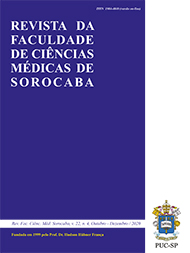Incidence of headache after subarachnoid anesthesia in a philanthropic maternity clinic
DOI:
https://doi.org/10.23925/1984-4840.2020v22i4a5Keywords:
headache, post-dural puncture headache, postoperative complicationsAbstract
Introduction: One of the complications of subarachnoid anesthesia is post-dural puncture headache (PDPH), occurring in approximately 1.5% of cases, with a debilitating characteristic that is a primary cause of morbidity and leads to an increase in hospitalization days. Objective: To study the incidence of post-dural puncture headache in obstetric patients with cesarean section in a tertiary health institution. Method: This is an observational, analytical study carried out in a tertiary hospital, with a sample of 100 patients (3 cases). Two-part forms were used: the first described the participants, and the second collected data on their PDPH. The primary outcome was presented as the incidence of the condition, with 95% confidence interval (95%CI). Cases were described after results analysis. Results: Results were divided into: epidemiological variables; variables related to pregnancy, labor, and delivery; variables related to patients’ comorbidities; and those related to PDPH. Regarding the subarachnoid anesthesia procedure, the type of needle used was reported in 69% of the records, and the only model used was the bevel cutting needle. The incidence of PDPH was 3%, varying from 0 to 6%. None of the 3 puerperal women presenting PDPH needed a peridural blood plug. Conclusion: The incidence of PDPH in the study institution was higher than that described in the literature, possibly associated with the exclusive use of a dural puncture needle with a cutting bevel. Statistically, the epidemiological characteristics and risk factors of patients with PDPH were similar to those of the group of parturient women that did not have...
References
Gyanesh P, Radhika K, Sinha M, Haldar R. Cefaleia pós-punção dural para cesárea: as estratégias preventivas são piores do que a cura? Rev Bras Anestesiol. 2015;65(1):82-3. https://doi.org/10.1016/j.bjan.2014.04.002
Vieira VLR, Macedo CF, Sousa Júnior EJM. Cefaleia pós-punção da dura-máter em obstetrícia. Rev Méd Minas Gerais. 2009;19(3 Suppl.1):S52-8.
Sinikoglu N, Yeter H, Gumus F, Belli E, Alagol A, Turan N. A reinserção do estilete não afeta a incidência de cefaleia pós-punção dural (CPPD) após raquianestesia. Rev Bras Anestesiol. 2013;63(2):188-92. https://doi.org/10.1590/S0034-70942013000200005
Oliveira RN, Grachten AP, Vinhas Filho JAV. Cefaleia pós-raquianestesia. Acta Méd (Porto Alegre). 2014;35:1-6.
Edvinsson L. IHS Classification ICHD-3 [Internet]. International Headache Society (IHS); 2014 [acesso em 31 ago. 2020]. Disponível em: https://ichd-3.org/.
Xu H, Liu Y, Song W, Kan S, Liu F, Zhang D, et al. Comparison of cutting and pencil-point spinal needle in spinal anesthesia regarding postdural puncture headache. Medicine (Baltimore). 2017;96(14):e6527. https://doi.org/10.1097/MD.0000000000006527
Zhang D, Chen L, Chen X, Wang X, Li Y, Ning G, et al. Lower incidence of postdural puncture headache using whitacre spinal needles after spinal anesthesia: A meta-analysis. Headache. 2016;56(3):501-10. https://doi.org/10.1111/head.12745
Neves JFNP, Monteiro GA, Almeida JR, Brun A, Sant’Anna RS, Duarte ES. Spinal anesthesia with 27G and 29G Quincke and 27G Whitacre needles: technical difficulties, failures and headache. Rev Bras Anestesiol. 2001;51(3):196-201. https://doi.org/10.1590/S0034-70942001000300002
Uyar Türkyilmaz E, Eryilmaz NC, Güzey NA, Moraloğlu Ö. Bloqueio bilateral do nervo occipital maior para tratamento de cefaleia pós-punção dural após cesarianas. Braz J Anesthesiol. 2016;66(5):445-50. https://doi.org/10.1016/j.bjan.2015.12.001
Neves JF, Vieira VL, Saldanha RM, Vieira Fde A, Coutinho Neto M, Magalhaes MG, et al. Hydrocortisone treatment and prevent post-dural puncture headache: case reports. Rev Bras Anestesiol. 2005;55(3):343-9. https://doi.org/10.1590/s0034-70942005000300011
Lee SIL, Sandhu S, Djulbegovic B, Mhaskar RS. Impact of spinal needle type on postdural puncture headache among women undergoing Cesarean section surgery under spinal anesthesia: A meta-analysis. J Evid Based Med. 2018;11(3):136-44. https://doi.org/10.1111/jebm.12311
Zorrilla-Vaca A, Makkar JK. Effectiveness of lateral decubitus position for preventing post-dural puncture headache: a meta-analysis. Pain Physician. 2017;20(4):E521-9.
Downloads
Published
How to Cite
License
Copyright (c) 2022 Revista da Faculdade de Ciências Médicas de Sorocaba

This work is licensed under a Creative Commons Attribution-NonCommercial 4.0 International License.
Os autores no momento da submissão transferem os direitos autorais, assim, os manuscritos publicados passam a ser propriedade da revista.
O conteúdo do periódico está licenciado sob uma Licença Creative Commons 4.0, esta licença permite o livre acesso imediato ao trabalho e que qualquer usuário leia, baixe, copie, distribua, imprima, pesquise ou vincule aos textos completos dos artigos, rastreando-os para indexação, passá-los como dados para o software, ou usá-los para qualquer outra finalidade legal.

 Este obra está licenciada com uma Licença
Este obra está licenciada com uma Licença 